Probably the biggest question I currently have about warships in the WWII era is how to understand the ships between the battleship and the classical treaty-type cruisers. A surprising number of navies investigated these, although only the USN built ships that fall at the core of this type.
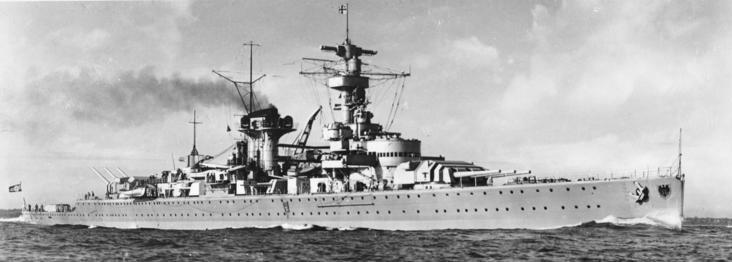
Deutschland/Lutzow
In a lot of ways, the progenitor of the type were the Deutschland class Panzerschiffe, built under the terms of the Treaty of Versailles. These limited Germany to ships of 10,000 tons and armed with 11" guns, with the obvious intention of Germany being able to build a few coastal defense ships to replace the pre-dreadnoughts they had retained after the war. The Germans decided to do something quite different, building what was known at the time as a "Pocket Battleship", with two triple 11" turrets, a speed of about 28 kts and an armored belt of 6-8 cm. The most unusual feature was their propulsion, provided by diesel engines, which gave the ships very long range. Ultimately, instead of being built to defend Germany's coasts, they were commerce raiders, intended to be capable of defeating anything that could match their speed with the exception of a trio of British battlecruisers. In practice, this didn't work as well as the Germans had hoped, with Graf Spee doing significant damage to Exeter at River Plate before being scuttled thanks to damage, while Lutzow was driven off by British cruisers during an attack on a convoy in the Barents Sea in the only other major action fought by the type.
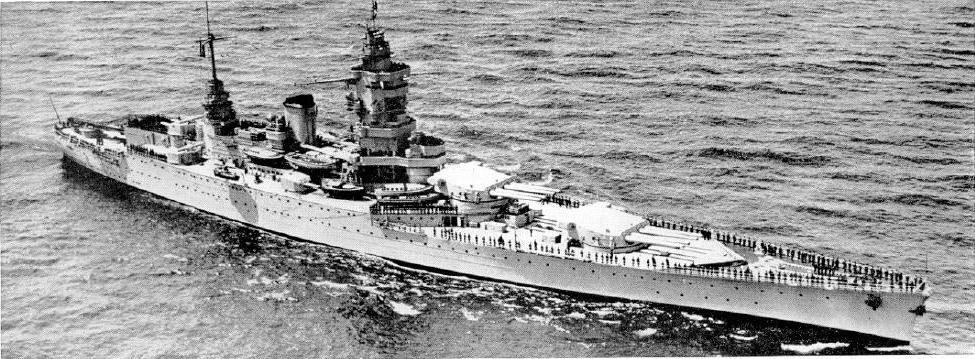
Dunkerque
Concerns about the Deutschland class played a major role in the next class that falls into this category, the French Dunkerque class. These were the first ships in the general battleship class built since the Nelsons, and were built at a time of great uncertainty for the capital ship. The British in particular were pushing for a limit of 25,000 tons and 12" guns at the 2nd London Conference, and the French decided to build their designs more or less along these lines, although the final ships had 330 mm (13") guns and a standard displacement of 26,500 tons, which was enough to make them superior not only to the Deutschlands, but also to the unmodernized Italian battleships, their other likely adversary. This, combined with the fact that they were universally built to battleship standards in areas like torpedo defense, means that modern scholarship places them clearly in the battleship tradition.
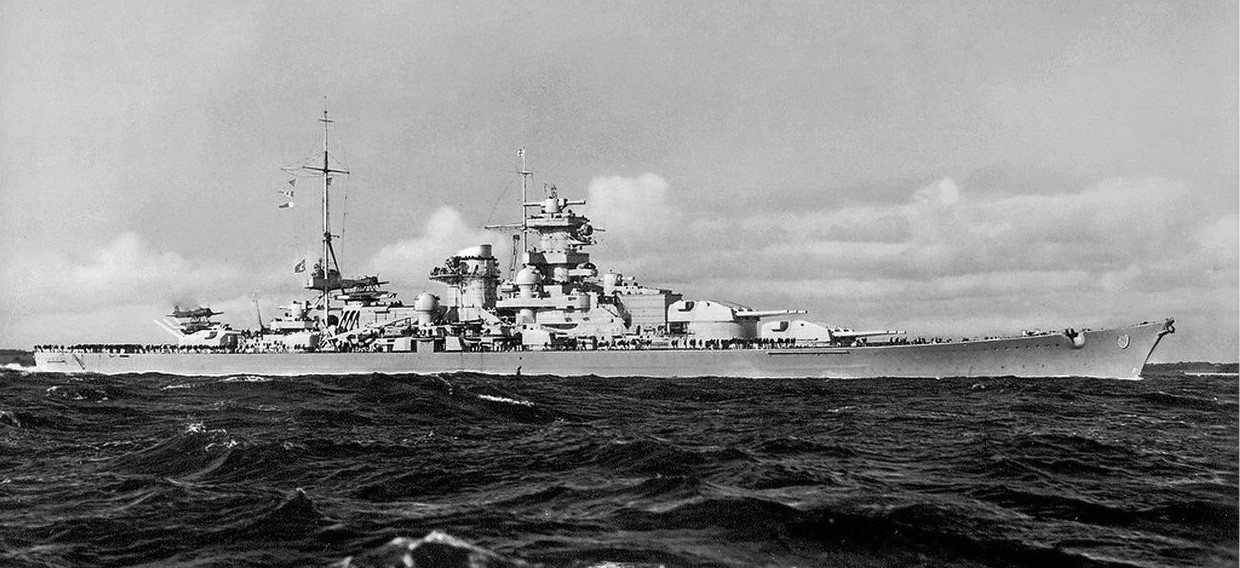
Scharnhorst
But they were still significantly smaller than the 35,000 ton treaty limit, and the big question was if other nations, most prominently Italy, would do so. As it turned out, they did not. Their analysis pointed towards bigger ships having a significant advantage, and so the Littorio class was built to the treaty limit, and even a bit beyond. The Germans, eager to curry favor with the British, built the Scharnhorst class slightly smaller and with 11" guns, although their declared 25,000 ton displacement was actually more like 31,000 tons when they were completed. But again, these were clearly in the mold of battleships, with small guns for political reasons, guns that the Germans were planning to replace with twin 15" before they decided to spend their resources invading Russia instead.
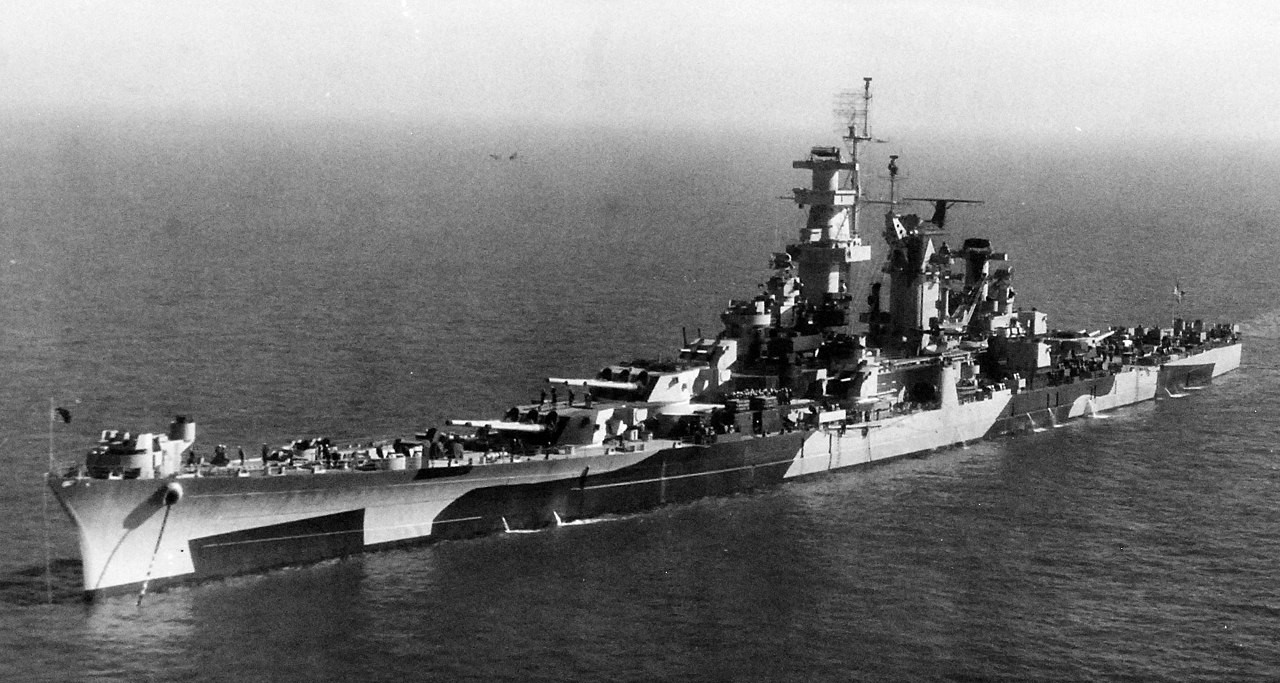
Alaska
But the Scharnhorsts were the last gasp of the smaller battleship, and afterwards, the trend was only bigger. Every subsequent battleship would be at least 35,000 tons, with designs not limited by treaty getting much, much bigger. But ships of this size soon reappeared, driven by the need for something that would overmatch the treaty cruisers that were likely to form the backbone of commerce raiding and protection while being smaller than a battleship. Only the American Alaska class was actually built, a ship that displaced 34,253 tons full, quite close to the 35,500 tons of Dunkerque and the 38,900 tons of Scharnhorst.1 But despite their similar sizes, the Alaskas had a very different design history than the previous ships. They were intended to hunt raiding cruisers, with all of their various features being clearly derivative of American cruiser practice. Their armor was built to fight somewhat off the beam, they completely lacked a torpedo defense system and had cruiser features like a single rudder and amidships aircraft facilities. The Alaskas were also capable of 33 kts, about 3 kts more than the previous two classes.

A sketch of the planned Design 1047 battlecruiser
The basic logic behind the Alaskas was compelling in other nations as well, most notably the Netherlands. In the late 30s, the Dutch thought that during any general war in the Far East the Japanese battlefleet would have to be deployed against the Americans and British, leaving them with nothing bigger than a heavy cruiser to use against the Dutch East Indies.2 The Dutch, whose previous attempt at building battleships had been aborted by WWI, turned to their close ally, Germany, to provide technical expertise and even the same guns that armed the Scharnhorsts. Even as war broke out in Europe, discussions continued, eventually producing designs for a ship capable of 34 kts and protected against both torpedoes and 8" guns, but at a major sacrifice in range. Unfortunately, the design process was interrupted before a final scheme was selected due to the German desire for even closer cooperation with the Netherlands in May of 1940.
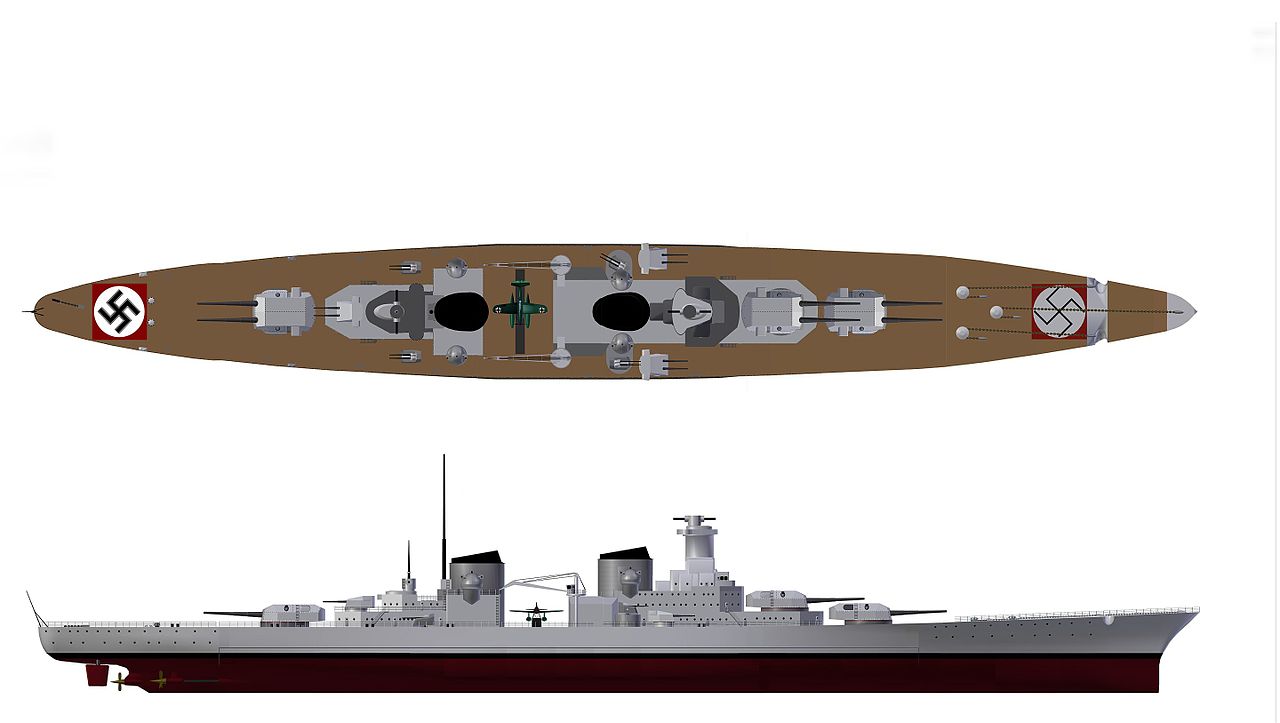
A drawing of the O class
The Germans had a design for an intermediate ship of their own. The P class cruiser had begun as a follow-on to the Deutschland class, with higher speed to avoid heavy ships, but had grown during the design phase to the point where they wanted a heavier armament, producing the O class. These were intended to operate alongside the German H class battleships, successors to the Bismarcks. The idea was that the H class ships would fight the battleships protecting British convoys while the Os broke past and attacked the convoy with their 6 15" guns, which had originally been procured to rearm the Scharnhorsts before that was cancelled due to rising international tensions. Fitting the guns and a speed of 33.5 kts into a 35,400 ton hull meant a number of sacrifices, most notably a belt of only 7.5" and a 2.4" main deck. The design was also equipped with a hybrid propulsion system, with diesel on the outboard shafts and steam on the centerline shaft to save space and weight. The last particularly interesting feature was the torpedo armament, 12 tubes in four triple mounts on the main deck to sink merchant ships quickly. Of course, Germany soon had higher priorities than new quasi-battlecruisers, and the design was pretty much dead on the outbreak of war.

Kronshtadt
But the O class wasn't the last ship planned to use those guns. The Soviet Design B had been largely intended to fight the Scharnhorsts and smaller ships, and despite its cancellation in 1937, Stalin was intent on building a cruiser-killer, which basically recycled the last, fairly small, Design B into the Kronshtadt/Project 69. This design was gamed against the Scharnhorst, Dunkerque and Kongo classes, and was intended to operate in the Black Sea and Pacific against lighter ships than the contemporary Sovetskii Soiuz. The result grew during design, from an early design of probably around 30,000 tons to a full 41,000 tons deep by the time they were ready to begin building, the biggest of the cruiser killer types. Unfortunately, the planned armament of 3 triple 12" turrets was well behind schedule, and the Soviets looked to the Germans, who were still a year or so away from invading. The Germans offered the spare 15" turrets, which the Soviets planned to modify the first two units of the Kronshtadt class to use. Work began on these ships in November 1939, but things proceeded slowly, and they were far from complete when the Germans invaded.
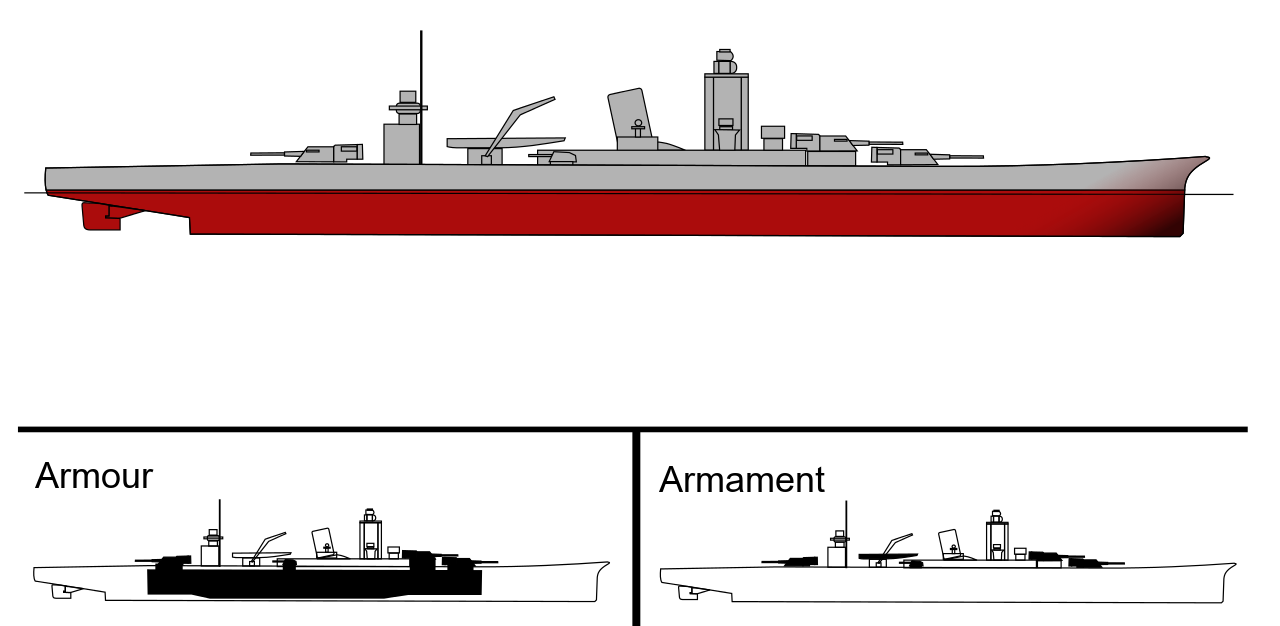
A sketch of the proposed B-65 design
The last player to get into the field was Japan. Unfortunately, little information is available on Design B-65, which appears to have originated as a replacement for the Kongos in support of the Japanese night attack strategy, although a lot of sources describe it as a response to the Alaskas. This is dubious given the development history, which saw full-scale TDS experiments in 1940 and trials of the 310mm guns in 1941. The design itself was fairly conventional, with a 7.48" belt sloped at 20°, and a proper TDS. None were laid down before Japan's decision to go to war brought long-term projects to a halt.
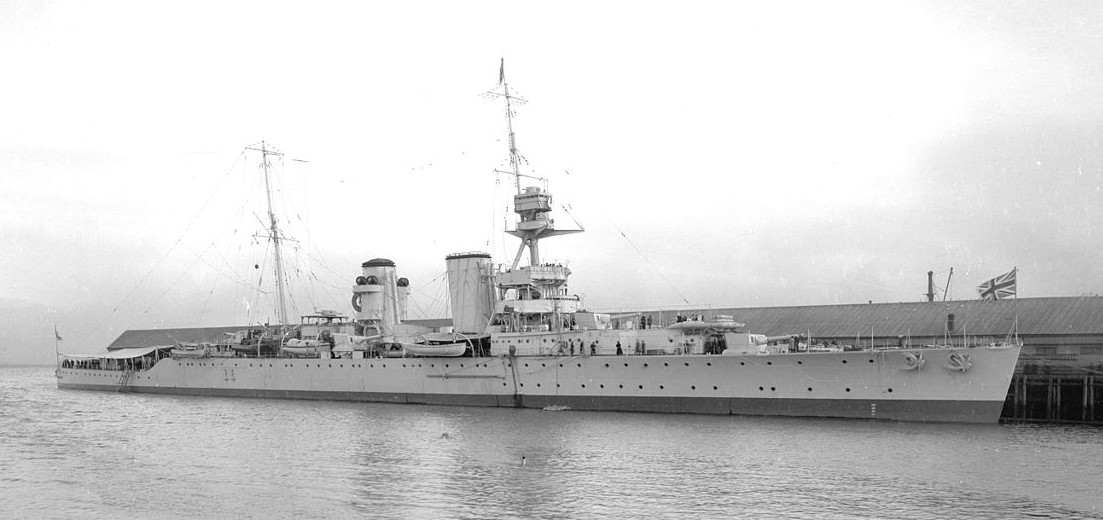
HMS Raleigh, of the Hawkins class
But what are we to make of this type of ship? The fact that so many countries built or planned ships in the 30-40,000 ton (full load) range suggests that there was a real niche for a ship capable of decisively overmatching a heavy cruiser but significantly smaller and cheaper than a full-size battleship. The war itself, and the radical changes in naval warfare it both drove and revealed, slammed the window shut on the type before it could be fully explored, but I can only conclude that there was a real type here. The obvious parallel is to the creation of the heavy cruiser with the Hawkins class, designed during WWI to take over the niche of an overseas ship that could handle smaller cruisers and the like, but that was much cheaper than a battleship.3 This view is supported by the appearance of the Soviet Stalingrad/Project 82 of the postwar years. This had originated as a smaller companion to the Kronshtadt, but by the time ships were actually laid down in the early 50s, it had grown into what looks like a somewhat faster version of the earlier ship. This was probably again driven by the need to outmatch existing heavy cruisers, although I don't have the one good source on these ships and thus can't be sure.
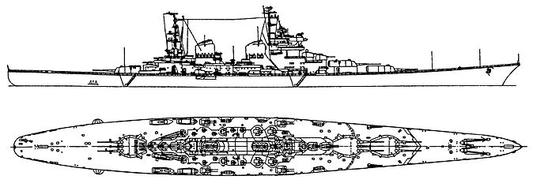
Stalingrad
The problem then becomes classifying them. I've previously held to the view that they were essentially large cruisers, on the basis that this is an entirely accurate description of the Alaska class, the only one I had dug deeply into. But looking at a wider view, the Alaskas are in many ways the outliers. Most of the others, whatever they were called, are more clearly small battleships than big cruisers.4 I still object to the term "battlecruiser" on the grounds that these ships are very different from the classical battlecruisers of WWI. Those were ships the size of contemporary battleships and capable of 25 kts or more. If we generalize the rule to "battleship size/type, but faster than normal", we can conclude that only the US built battlecruisers in the Treaty era in the form of the Iowas. While I am well aware that nomenclature drifts over time, calling the ships discussed here "battlecruisers" seems like a major culprit in the confusion over the WWI type, which I am trying to aid in the rehabilitation of.
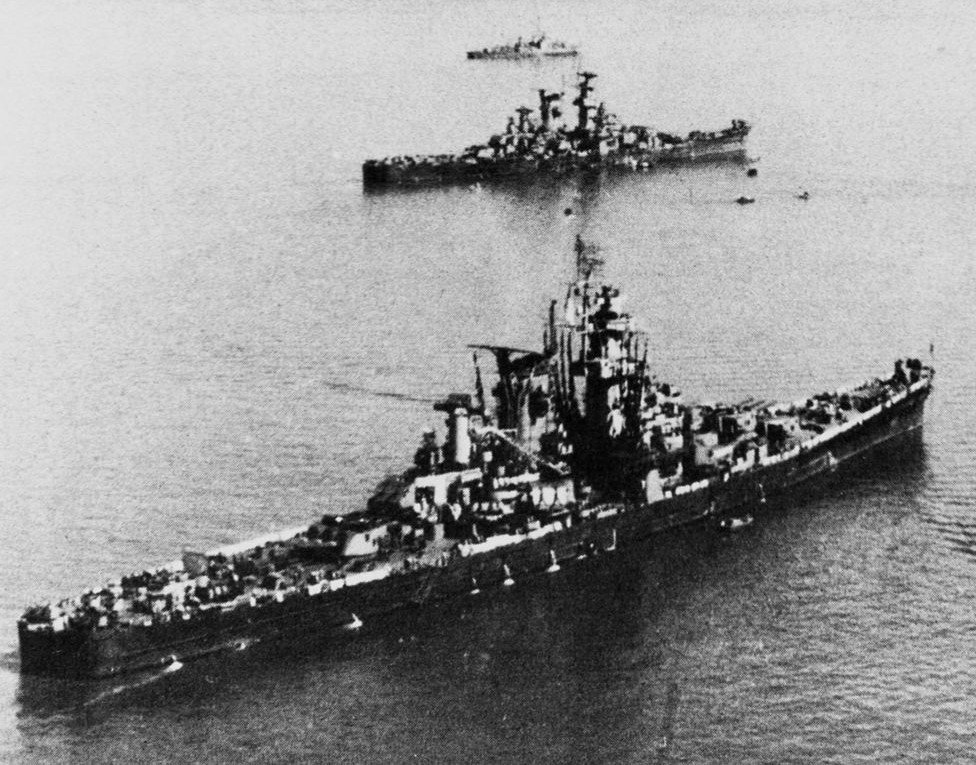
The true cruiser-killers
I think my conclusion to all of this is that the best description of the type is probably cruiser-killer.5 It describes the mission cleanly, is in reasonably common use, and doesn't imply membership in the cruiser category the way that "large cruiser" does. But at the same time, they are a branch of the battleship family. Some units, specifically the Dunkerques and Scharnhorsts, are part of the main thread of battleship development, while others are a fascinating branch that might have been something much bigger if not for aircraft and the atomic bomb.
1 Yes, I know these are different from the numbers given above. Displacement is horrible, and I tend to think that using full-load displacement is the best way to compare ships, because it reduces the chances for national differences to mess with the results. ⇑
2 What is today Indonesia. ⇑
3 In fairness, this role had previously been handled by the old armored cruisers, which were becoming increasingly obsolete by 1915 or so, when work the Hawkins began. ⇑
4 The matter of speed does bear mentioning. Most of these ships were in the 33 kt range, a couple knots faster than the relevant nation's battleship. To some extent, they may have been intended to form the fast wing of the battle force, at least when dealing with lighter/older battleships. The one obvious exception is the Alaskas, which were not intended to fight enemy battleships at all, but that probably also had a lot to do with the Iowas. ⇑
5 No, this wasn't where I started. I wrote the post title later. ⇑

Comments
Isn't it impolite to use 'kill' as part of a class designation? I think 'destroy' is the preferned verb. So, we would have cruiser-destoryers. : )
The concern about "cruiser-destroyer" is that destroyer is already a type of ship, and it would imply something halfway between a cruiser and a destroyer. (Note that the term was mooted for the Tribal class DDs in the 30s to imply exactly that.) Cruiser-killer is also in reasonably broad use for these ships, which pushes towards using it.
I see not one but two categories here.
The main category (Alaska, Deutschland, O class) are next-gen cruisers (whether the emphasis is on independent operation or as part of the battlefleet screen). Just as battleship displacements and speeds increased from pre-dreads through "standard" dreads to fast battleships (incl. Hood), and destroyer displacements increased over time (mentioned Tribals, US "frigates"), of course cruiser displacements would gradually increase over time. Just ask Sen. Tillman.
Whereas (Dunkerque, Scharnhorst) are treaty weirdness small battleships. The choice of their size was driven entirely by politics, not technical decisions.
Regarding there being two categories here, I think that's kind of a natural evolution of the entire arms race. The same thing comes up organically when some of us world-builders start designing space fleets, too, ending up with "battlecruisers" and "light dreadnoughts", being essentially beefed up cruisers and cut-down battleships by lineage, but both winding up in this "built to outfight cruisers" category. I'm not entirely surprised that the same thing came up, driven by somewhat similar considerations, in reality.
I think it almost happened again in the Cold War, with the Russian Kirov and US CSGN concepts, except that a combination of factors, both technological and doctrinal, led away from it. (Though the Kirovs got built anyway, and the Slavas too, though arguably they're less cruiser-killers than they are the guided-missile-era equivalent of 8" gun cruisers. And evidently made of tinder and rice paper.)
That was more or less where I started from, but that sort of breaks down when you look at other ships. The Deutschland class aren't really in this category at all, but need mention given their importance to its development. The Alaskas are very cruiser-like, and the Os fall in that direction, but everything else in the later generation seems to fall more on the small battleship side. Yes, Dunkerque and Scharnhorst are weird political sizing, but the rest of the ships aren't.
I'm one who is very definitely on the "they are battlecruisers" side. My classification rule is that if your main broadside is heavier than HMS Dreadnought, you can't be a cruiser.
Put Dunkerque next to Lion, or Alaska next to Derfflinger, and it's hard to tell them apart. Put Lion or Derfflinger next to any WW2 cruiser, Baltimore, Prinz Eugen, Zara, London, and it's very easy to tell them apart.
Are they the same as WW1 battlecruisers? Not exactly. But we subdivide battleships into dreadnought, superdreadnought, treaty, post-treaty, etc; we subdivide cruisers into light, heavy, AA. So if you want to subdivide battlecruisers (there really aren't that many compared to anything else), fine by me.
Also, we have BB / CV / SS Categories on the side-bar. Could we have ones for DD & C* ?
OK, trying again.
Toothless battleships, that get eaten while being too expensive for that: Dunkerque, 11" Scharnhorst, 1047 (they are contesting the IJN in the impressively arrogant design assumptions competition).
Cruisers (defined by design mission): Deutschland, Alaska, B-65.
Shipless battleteeth: O class, Kronstadt. That set of 15" guns must have been cursed. They are so tempting to shoot at a BB and are overkill for anything else.
Maybe an actual battleship: 15" Scharnhorst.
What would probably make the most sense in the abstract would be to redesignate the likes of HMS Invincible and SMS Moltke as "fast battleships", reserving "battlecruisers" for this newly identified class of ships heavier than heavy cruisers but distinctly lighter than either fast or regular battleships and clearly not intended to go toe-to-toe with the latter.
But that's ludicrously impractical given all the stuff out there referring to classic battlecruisers as battlecruisers, including universal contemporary reference to them as such.
Another possibility would be to take the Panzerschliffes as archetypical of these "cruiser-killers" and call the breed as a whole "pocket battleships". This has the advantages of a bit of consistency with contemporary nomenclature and of emphasizing that (apart from the Alaskas) they resemble small battleships more than they resemble large cruisers. But perhaps it overemphasizes the latter, since as you say they're intended for cruiser-hunting, not for standing in the line of battle like a true battleship, or even for being a scouting-and-flanking element of the line like classical battlecruisers.
@Hugh
I think you misunderstand me. I'm not trying to exclude them from the capital ship category, which I agree is a place where they belong. These aren't really cruisers, even if the Alaskas mostly look that way. But I don't want to use the term battlecruiser, for reasons listed in my penultimate paragraph. Also, what Eric said.
@ike
Unlikely. It would be a lot of work to go back and re-tag old posts.
@Basil
I think there's enough commonality to call these a type. There were significant doctrinal differences between the treaty battleships, but nobody has problems treating those as generally of a single type.
@Eric
I completely agree with you on Invincible et al.
I probably should have been clearer that the Panzerschiffe aren't of this type. They're very much in the cruiser category in things like size and armor. I just discussed them here because I had to. Also, I really don't like the term "pocket battleship" for reasons I don't entirely understand.
It seems to me that a "pocket battleship" would be a ship that's a BB in most respects, but is small. Slow, short legs, one or two turrets, but 12-16" guns and armored against the same. Or possibly a battleship shrunken in all regards like the Finnish coastal defense ships.
Despite most of these ships being more cut-down-BB than beefed-up-CA, I would also object to the term "pocket battleship" as most of them are neither "pocket" nor "battleship" despite the design lineage. "Light dreadnought" possibly?
To me the Alaskas are the Invincibles of WW2, completing the circle back to the original. Bean, when you write that the Alaskas "with all of their various features being clearly derivative of American cruiser practice" you could just as accurately be describing HMS Invincible.
In 1906 the RN took their current armoured cruiser hull, scaled it up, and made the guns 12". Intended role was to hunt 10-15,000 ton cruisers with 7.5-9.4" guns. In 1940 the USN took their current cruiser hull, scaled it up, made the guns 12", intended to hunt 10-15,000 ton cruisers with 6-8" guns. (And Panzerschiffe with 11".)
They're not identical, and Invincible in particular is more innovative in design, but I don't see any need for a different classification.
I have trouble seeing the Dunkerque as a small battleship, because her armour is only a little better than Alaska and not up to preceding battleship standards let alone current. The French aren't trying to protect her against her own guns.
According to Robert Dumas, Les Cuirassés Dunkerque et Strasbourg, the requirement for Dunkerque was protection against the German 11"/280mm gun as carried by the Panzerschiffe. Even in 1918 that would probably not be considered battleship grade, in 1930 it clearly isn't and the French knew it. Strasbourg got an extra inch of belt and turret because the Germans were putting a modern 11"/280mm gun on Scharnhorst, but that's still not enough armour to go up against anyone else's battleships.
Dumas doesn't mention anything about fighting Italian battleships, probably because at the time the French and Italian navies had equal numbers of ancient WW1 battleships. The Dunkerques were expected to hunt the Italian heavy cruisers.
All in all, closer to battlecruisers than battleships for me.
@Hugh
I completely agree that there is a great deal of commonality between Alaska and Invincible, and if you want to define "battlecruiser" based on the commerce-protection role, I will grant that as a coherent, if somewhat odd, position. The problem is all of the other BCs, some of which were very clearly not built for that. The rule of "battleship size, speed 25+ kts" perfectly sorts described battleships and battlecruisers pre-treay with one very late exception (Nagato). That seems like a far better definition to start from when deciding what ships to include, and the Alaskas clearly fail the first prong.
Re Dunkerque, I'm working from Dumas and Jordan, French Battleships 1922-1956. From p.31, talking about the modifications to the design when they increased the displacement to 26,500 tons and upgunned to 330 mm: "Protection was now on a scale that would make the ships invulnerable not only to the German 28cm shell, but also to the 305mm shell of the older Italian battleships. This was a sound move, in that the Marine Nationale could employ the new ships both against the German Panzerschiffe in the North Atlantic and, should the situation arise, against the Italian battle fleet in the Mediterranean..."
I would agree that if we were in 1935, describing Dunkerque as a battlecrusier would make a lot of sense, given the background you're seeing her against. But against the background of other fast battleships, she looks far less distinct, and modern scholarship has swung to putting her in the battleship camp.
The term "jaegerschiffe" is probably extremely anti-traditional for naval terminology; but "hunting ship" seems weirdly generic
I'd say the Invincibles look more like contemporary battleships (especially the Bellerophons) than they do Armoured Cruisers. They've got almost identical costs and displacements, identical weapon types, and similar weapon layouts. The main differences are that the Invincibles are a bit longer and narrower (necessary for higher design speeds), have more powerful engines (likewise), have one fewer main turret and less armor (gotta give up something to fit bigger engines into the same budget) and much smaller cruising ranges (likewise). The smaller cruising ranges in particular would be a curious choice if the Invincibles were primarily intended for the cruiser-killer role.
These are very similar tradeoffs to those between the Iowas and most of the BB65-series working designs under consideration for the Montanas in 1939 when the Iowas were ordered (of course, the Montanas as eventually ordered in 1940 would be quite a bit bigger since Treaty limitations were no longer a factor). The difference in belt armor was less extreme, about 25% for most Montana designs vs about 50% for the Invincibles compared to the Bellerophons.
Another argument for the Invincibles being fast battleships is that the German Navy felt the need to build similar ships of their own to counter them, and to deploy said ships with the main High Seas Fleet in Wilhelmshaven instead of on foreign stations. If we think of that generation of battlecruisers as primarily cruiser-killers, building them at all seems a bit frivolous for the Kaiserliche Marine since each BC means one fewer BB, and stationing them where in wartime they'd get bottled up in the North Sea seems foolish. But if we think of them as fast battleships intended primarily for a role in major fleet engagements, both the decision to build them and the decision to station them with the main fleet make much more sense.
@Eric
Hugh is right so far as the Invincibles go. It's all over the design documents, and they were referred to as "dreadnought armored cruisers" for several years before battlecruiser was coined. But the late armored cruisers were fast capital ships, and Invincible's armor layout is almost exactly the same. Assuming you're working from Wiki's range figures, the one for Invincible is listed by RA Burt as being sans oil, while the one for Bellerophon is the number he gives with oil. Under those conditions, Invincible can make 6,020 nm. (Range figures are terrible, those from this era more than most.)
But this only applies to the British 12" BCs. The German BCs were built under different design assumptions, with the intent of producing a fast wing of the battle fleet, and that was also more or less the intent for Lion et al.
Yes, I was working from wikipedia's numbers. I stand corrected.
What mildly annoys me is that "Cruiser" notionally derives from "ships that Cruise" - IE, are intended to be far from port and support. A battlecruiser ought to be "a ship that battles cruisers"; IE, this cruiser-killer.
Instead it's a Fast Battleship.
I would say that the more logical interpretation of "battlecruiser" would be a ship that battles and cruises; "cruiser" as the root word and "battle" as the modifier telling you what kind of cruiser it is.
Somewhat oxymoronic given that in naval usage "cruising" is something done by a lone ship (or very small group), whereas "battle" is an engagement of fleets (anything less is an "action"). But that points to the flexibility of a traditional battlecruiser. A ship that only hunts cruisers and that you wouldn't expect to directly engage enemy battleships in the the really big fights, is a cruiser-killer. A Heavy Cruiser, or an Even Heavier Cruiser. The Alaskas probably fit there.
If the intent is that you might send it off alone to hunt down cruisers or take on enemy battleships in a fleet engagement, it's a battlecruiser. And I think that is a good fit for e.g. the Dunkerques.
If it's fast but too big and expensive for you really to send it out chasing down lone cruisers, it's a fast battleship.
Submitting "super-heavy cruiser" for Alaskas and similar, as well as the earlier Deutschlands, and "light battleship" for Dunkerque-likes. Admittedly "light BB" sounds weird, but I think that fits the ships in question, and it's better than "pocket". Whereas "super-heavy" expresses the fact that they're the next step of the cruiser concept, still not meant to come under heavy fire.
And I'd reserve "battlecruiser" for the WW1 ships, which merged/evolved into the fast battleship type of later days.
My rule for battlecruisers would be 20000 tons full/deep displacement; guns over 10"/255mm; design speed 24 knots to 1910/27 knots to 1920/30 knots after that.
Alaska is battleship size! At launch she displaces more than fellow USN battleship Arkansas; French Courbets, Bretagnes, and Dunkerques; Italian Cavours, and Dorias.
When you write "all of the other BCs" that isn't a big number. The Brit 12" battlecruisers are at least one-third of all the BCs that the RN ever built, and one-fifth/one-sixth of all the BCs worldwide depending on what you include. So yeah I group the Invincibles, Indefatigables, and Alaskas together as "battlecruisers, pursuit" or whatever is an appropriate name for ships designed to protect commerce by blasting cruisers out of the water. The later British BCs and I guess the German can be "battlecruisers, fleet" or something.
It occurs to me that I don't know why the Japanese built the Kongos in the first place and what they were planning to do with them pre 1930 or so. Anyone?
First, I should point out that anyone expected sense out of ship designation is probably going to be disappointed. Yes, I can think of several elegant and sensible schemes that are rather at odds with what we call actual ships. So for both philosophical and practical reasons, I'm going to stick with making any proposals interoperable with existing nomenclature. I also don't particularly like schemes that take ships that are close in time and very similar in characteristics and shunt them into very different categories based on what the people who ordered them were thinking, because that seems to hinder understanding.
@Hugh
Your rule identifies about half of the treaty battleships as BCs. That's not necessarily wrong (and I think it's very right for the Iowas) but it does make things a bit weird. I'd also suggest that if the speed ceiling is going to rise, the tonnage threshold should as well.
Battleship size isn't constant, and there's a reason I'm careful to say "contemporary" when I talk about this stuff. Alaska was the size of a battleship from 30 years earlier, and a few ships from that far back survived because of the treaties.
Re the percentage of Invincibles, I agree that they were a significant fraction of the BCs, but I will point to the size issue and the fact that a lot of the other cruiser-killers don't fit so neatly into that mold, but look an awful lot like the Alaskas. A lot of this is just a philosophical issue, and I've decided to go with battlecruiser minimalism because I think that's less confusing than battlecruiser maximalism for what I'm trying to do. If you want to go the other way, have fun.
I would guess that they were trying to build a fast wing of the battle fleet, given what little I know of their design. Unfortunately, Japan is by far the biggest gap in my knowledge of design history and purpose.
Has anyone looked at this quantitatively? Take the relevant parameters - displacement, armour mass, speed, etc. - and correct them for national idiosyncrasies to make them directly comparable, plot historical warships in the multidimensional space defined by those parameters, and run them through a clustering algorithm to see whether they actually form distinct types?
When I see a lot of debate over something with low N, I start to worry that the data are being over-interpreted. A numerical confidence that warships really do fit into clusters corresponding to these distinct types would reassure me, and might even offer some objective motivation on how to classify the oddballs.
I suppose if we're looking for a German designation for the type, how about "kreuzerjäger"?
@DampOctopus
I haven't, on the grounds that the "correct for national idiosyncrasies" is going to take a ton of work. The best source for that I know of is Friedman's Battleship Design and Development, and most of these ships aren't in there. More than that, while there is frequently some distinction between types, it's never going to be completely clean clusters unless the treaties are enforcing distinctions. But at the same time, there's a lot of ships designed that were below the 35,000 ton limit, and it seemed worth looking at them to see if there were commonalities. I saw enough that I think the type is a useful lens, hence this post.
@Jade: the Finns weren't the only ones - several nations had a 2-4x8-11" gun ship as their largest type.
I'm not sure why those continued to be built into the dreadnought era, while 2x15" ships were considered shore bombardment only and both cruisers and full-size (or nearly-full-size, as described here) battleships had 8+ guns.
(I'm also not sure if it's meaningful that the "small battleship" types were their nation's top tier (at the time), while the "large cruiser" types (would have) had full battleships above them.)
They weren't meant to fight a Great Power navy in blue water. In the islands and inlets of a Scandinavian coastline, they would have outgunned anything small enough to actually maneuver, and if a real battleship, with its deep draft, were stupid enough to come in after them - why, that's what the minelayers are for.
(This is speculative.)
That does make sense: one problem with having a small number of large (and hence slow-firing) guns is that it takes too long to get enough spotting data to hit at long range. If you're defending a port with steep fjords/islands, you have the option of taking cover in/behind those and only coming out to fight when the enemy is close enough (and possibly unable to dodge because they're in a narrow channel) that hitting is easy.
(You still might get surprise-killed before you properly realize you're at war, but that's also true of full-size battleships.)
The lack of larger versions might then be because 8-11" is enough to penetrate practically anything at short range, and it's not worth caring about long-range penetration if you mostly can't hit at long range. (While the 2x15" monitors can (eventually) hit at long range, because they're shooting at land targets that can't dodge or usefully shoot back.)
This predicts that nations with a similarly limited budget but not such terrain would prefer something with more smaller guns, which they possibly did.
In terms of defining "battlecruiser", I have a rather controversial suggestion.
Held: The complete list of battlecruiser classes constructed is as follows: Invincible, Indefatigable, Courageous, Renown, Dunkerque, Alaska. All those other things people call battlecruisers are armoured so as to have a chance against battleships, and are thus actually fast battleships themselves.
(I don't know if I actually believe this, but cruiser-killer was the whole point of the BC originally, and I believe that those are the only ones that were actually built for the cruiser-killer role.)
That's a consistent and defensible position, and one I reject mainly because it is so strongly at odds with conventional use of the term. That said, I would point out that Dunkerque was armored against the guns of the battleships she was most likely to face, and given the limitations of shells c.1904, it's not entirely clear that Invincible wasn't protected against battleship guns when she was designed.
"That set of 15″ guns must have been cursed" Whatever happened to them, anyway?
(There has got to be some way of plausibly teaming them up with the Demon Core for Great Awesome. Somehow)
I am not sure offhand. Probably scrapped in Germany postwar. I don't think they ended up in coastal batteries, which happened to some of the guns planned for the H class.